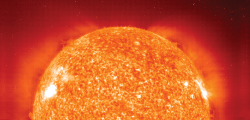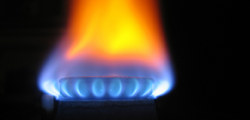|
Energy is a fundamental essence of our universe but also a slippery concept to get a grip on. Energy measures the capacity for change. Energy can create changes in speed, height, or temperature—or even turn matter from liquid into gas or back. Anything that changes over time by moving, turning on, or even living changes through the flow and transformation of energy. Without energy nothing can change—not speed, height, temperature, or even color. Understanding the flow of energy through matter opens a powerful window into understanding how things work. 
|
Forms of energy
|
 Mechanical energy is energy that comes from position or motion. Gravitational potential energy, elastic potential energy, rotational energy, and ordinary kinetic energy are examples of mechanical energy.
Mechanical energy is energy that comes from position or motion. Gravitational potential energy, elastic potential energy, rotational energy, and ordinary kinetic energy are examples of mechanical energy. 
|
 Radiant energy includes visible light, microwaves, radio waves, x-rays, and other forms of electromagnetic waves. Nearly all the energy on Earth ultimately comes from radiant energy that originates in the Sun.
Radiant energy includes visible light, microwaves, radio waves, x-rays, and other forms of electromagnetic waves. Nearly all the energy on Earth ultimately comes from radiant energy that originates in the Sun. 
|
 Nuclear energy, sometimes called atomic energy, is energy contained in matter itself. Nuclear energy can be released when atoms are changed from one element into another, such as in a nuclear reactor or in the core of the Sun.
Nuclear energy, sometimes called atomic energy, is energy contained in matter itself. Nuclear energy can be released when atoms are changed from one element into another, such as in a nuclear reactor or in the core of the Sun. 
|
 Electrical energy moves in the form of electric currents that flow in response to electrical voltages, such as in a battery or wall socket. Electrical energy is used whenever we turn on an appliance such as a lamp or coffee maker.
Electrical energy moves in the form of electric currents that flow in response to electrical voltages, such as in a battery or wall socket. Electrical energy is used whenever we turn on an appliance such as a lamp or coffee maker. 
|
 Chemical energy is stored in the bonds between the constituent atoms in molecules that make up most matter. Chemical energy can be released by rearranging the atoms into different molecules, such as by burning natural gas to produce water and carbon dioxide.
Chemical energy is stored in the bonds between the constituent atoms in molecules that make up most matter. Chemical energy can be released by rearranging the atoms into different molecules, such as by burning natural gas to produce water and carbon dioxide. 
|
 Thermal energy is another word for heat. Thermal energy is energy that is attributed to an object’s temperature. Hot objects have more thermal energy than cold objects.
Thermal energy is another word for heat. Thermal energy is energy that is attributed to an object’s temperature. Hot objects have more thermal energy than cold objects. 
|
 Pressure is a consequence of thermodynamic energy—a form of mechanical energy at the microscopic level—that is important in gases and liquids. It takes work to inflate a tire; some of the work is stored as energy in the form of high-pressure air inside the tire.
Pressure is a consequence of thermodynamic energy—a form of mechanical energy at the microscopic level—that is important in gases and liquids. It takes work to inflate a tire; some of the work is stored as energy in the form of high-pressure air inside the tire. 
|
When you burn oil, you are converting _______ energy to _______energy. - mechanical; chemical
- nuclear; mechanical
- chemical; thermal
- electrical; radiant
 |
The correct answer is c: chemical; thermal. When you burn oil, you break the molecular bonds inside of it, changing the hydrocarbons into carbon dioxide and releasing energy in the form of heat. 
|

